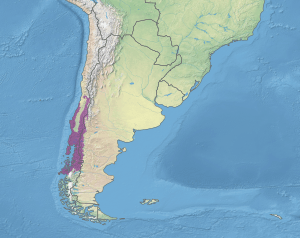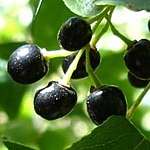Aristotelia chilensis
Aristotelia chilensis, known as maqui or Chilean wineberry, is a tree species in the Elaeocarpaceae family native to South America in the Valdivian temperate rainforests of Chile and adjacent regions of southern Argentina. Limited numbers of these trees are cultivated in gardens for their small fruits, known as maqui berries. Most of the fruits commercially marketed come from the wild.
| Aristotelia chilensis | |
|---|---|
 | |
| Maqui tree with fruits | |
| Scientific classification | |
| Kingdom: | Plantae |
| Clade: | Tracheophytes |
| Clade: | Angiosperms |
| Clade: | Eudicots |
| Clade: | Rosids |
| Order: | Oxalidales |
| Family: | Elaeocarpaceae |
| Genus: | Aristotelia |
| Species: | A. chilensis |
| Binomial name | |
| Aristotelia chilensis | |
 | |
| The native area of the rainforest | |
| Synonyms | |
| |
Description
Tree
Aristotelia chilensis is a small dioecious evergreen tree that can reach 4 to 5 metres (13 to 16 ft) in height. Its divided trunk has a smooth bark. Its branches are abundant, thin and flexible. Its leaves are simple, opposite, hanging, oval-lanceolate, naked and coriaceous, with serrated edges. The leaf venation is highly visible, and the leaf stalk is a strong red color.
In the beginning of spring, the tree sheds the old cohort, which is used as a carbohydrate source to form the new leaves and flowers.[2]

Flowers and berries
When A. chilensis flowers at the end of spring, the white flowers are unisexual and small, but they eventually yield a small edible fruit. The small purple-black berries that form are approximately 4 to 6 millimetres (0.16 to 0.24 in) in diameter and contain 4 to 8 angled seeds. A seven-year-old tree can produce up to 10 kilograms (22 lb) of berries per year. With fruit that tastes similar to blackberries, the species is known as the Chilean wineberry, and locally in Spanish as maqui or maque.
Distribution
Aristotelia chilensis is native to Chile and Argentina near the southwest coast of South America.[1] It is found naturally in Chilean rainforests. Its native area includes the Coquimbo and Aysén regions of Chile, and is 170,000 hectares (420,000 acres) in total.[3]
Ecology
Maqui berries are a favored food for birds at the end of summer. Deforestation of the Valdivian temperate rainforests in Chile suppresses seed dispersal by birds and leads to inbreeding depression.[4]
Harvesting and cultivation
The berries of A. chilensis are collected from wild plants from December to March of each year by families, mainly Mapuche, who collect their harvest near the Andes Mountains. The harvesting process involves collecting the side branches of trees, shaking them to separate the berries and leaves from the branches, and then employing a mechanical process to separate the berries from the leaves.
The stored fruits are sold in local markets, with prices ranging from $6.5 to $15 per kilogram ($2.9 to $6.8/lb). The average area yield is about 220 kilograms (490 lb) per hectare annually, with an estimated yearly total of only 90 short tons (180,000 lb), due to remote access and difficulty for transportation.
Aristotelia chilensis is planted in home gardens and is not grown on an orchard scale. Most of the fruits on the market come from the wild. Maqui is frost sensitive and fairly tolerant of maritime exposure. It prefers a well-drained soil in full sun, but with some protection against cold, drying winds. The soil should be slightly acidic with moderate fertility.[5]
Aristotelia chilensis can be planted in USDA zones 8 to 12. It is cultivated in Spain, and in milder, moister areas of Britain, where winter frosts reduce plant stock, thereby stimulating growth of more shoots in spring.[6]
Propagation
Seeds of A. chilensis germinate without cold stratification. In zones with the possibility of frost, it is recommended to sow in spring in a greenhouse. If they have grown enough, by autumn, the new plants can be planted into individual pots . The potted plants should stay in the greenhouse for the first winter.
The following year, after the last expected frost in spring, the plants can be planted out into their final positions. In their first winter outdoors, some type of frost protection is required.[7] For further propagation, vegetal reproduction is possible: cuttings of wood with a length of 15 to 30 centimetres (5.9 to 11.8 in) can be planted into pots. These cuttings normally root, and can be planted out in the following spring.[8]
Anthocyanin content
Only limited polyphenol research has been completed on the maqui berry, which showed its anthocyanin content to include eight glucoside pigments of delphinidin and cyanidin, with the principal anthocyanin being delphinidin 3-sambubioside-5-glucoside (34% of total anthocyanins).[9][10] The average total anthocyanin content was 138 milligrams (2.13 gr) per 100 grams (3.5 oz) of fresh fruit, or 212 milligrams (3.27 gr) per 100 grams (3.5 oz) of dry fruit,[10] ranking maqui berries low among darkly pigmented fruits for anthocyanin content (see table at anthocyanins). One study found that anthocyanins are also present in maqui leaves.[11]
References
- "Aristotelia chilensis (Molina) Stuntz". Plants of the World online. Royal Botanic Gardens, Kew. Retrieved 2018-06-21.
- Prado, C. & Damascos, M. (2001). Gas exchange and leaf specific mass of different foliar cohorts of the wintergreen shrub Aristotelia chilensis (Mol.) Stuntz (Eleocarpaceae) fifteen days before the flowering and the fall of the old cohort. Brazilian Archives of Biology and Technology, 44(3), 277-282.
- Nahuelhual L.; Carmona A.; Lara A.; Echeverría C.; González M. E. (2012). "Land-cover change to forest plantations: Proximate causes and implications for the landscape in south-central Chile". Landscape and Urban Planning. 107 (1): 12–20. doi:10.1016/j.landurbplan.2012.04.006.
- Valdivia, C. & Simonetti, J. (2006). Decreased frugivory and seed germination rate do not reduce seedling recruitment rates of Aristotelia chilensis in a fragmented forest. Biodiversity and Conservation, 16(6), 1593-1602.
- Huxley, A. (1992). The New RHS Dictionary of Gardening.
- Grey-Wilson, C., & Matthews, V. (1983). Gardening on Walls. London.
- Bean W. 1981. Trees and Shrubs Hardy in Great Britain. Vol 1 - 4 and Supplement.
- Chittenden, F. (1951) RHS Dictionary of Plants plus Supplement. Oxford University Press.
- Fredes C, Yousef GG, Robert P, Grace MH, Lila MA, Gómez M, Gebauer M, Montenegro G (2014). "Anthocyanin profiling of wild maqui berries (Aristotelia chilensis [Mol.] Stuntz) from different geographical regions in Chile". J Sci Food Agric. 94 (13): 2639–48. doi:10.1002/jsfa.6602. PMID 24497378.
- Escribano-Bailón MT, Alcalde-Eon C, Muñoz O, et al. (2006). "Anthocyanins in berries of Maqui (Aristotelia chilensis (Mol.) Stuntz)". Phytochem Anal. 17 (1: Jan–Feb): 8–14. doi:10.1002/pca.872. hdl:10366/141047. PMID 16454470.
- Suwalsky M, Vargas P, Avello M, et al. (Nov 2008). "Human erythrocytes are affected in vitro by flavonoids of Aristotelia chilensis (Maqui) leaves". Int J Pharm. 363 (1–2): 85–90. doi:10.1016/j.ijpharm.2008.07.005. PMID 18687390.
External links
![]()